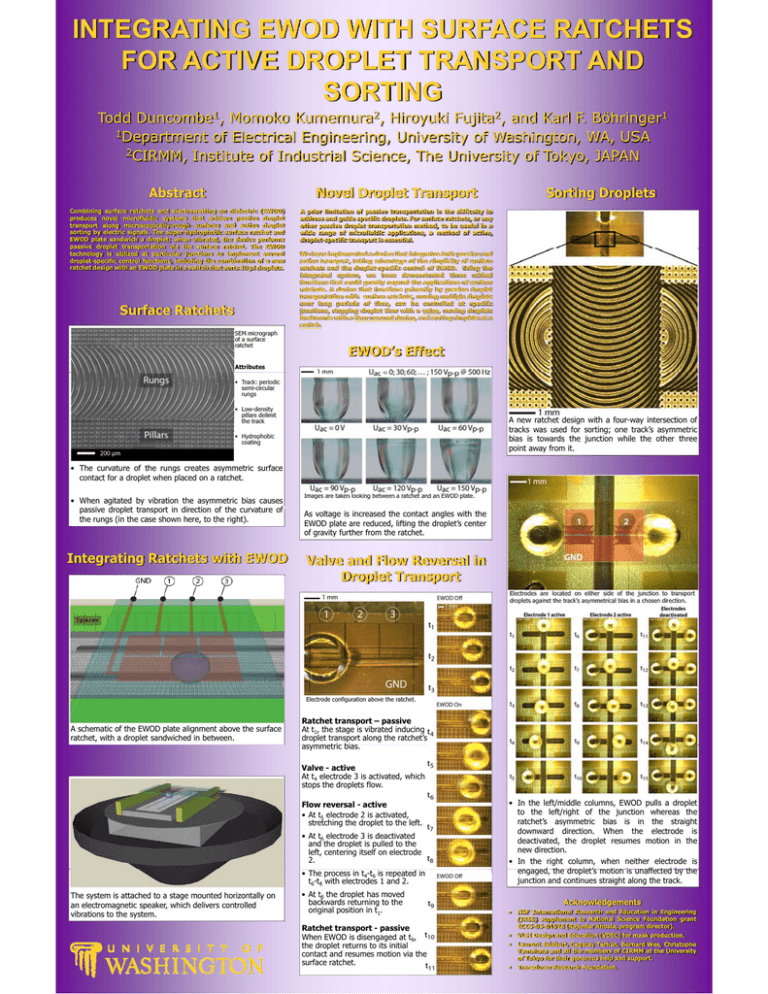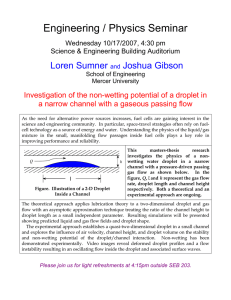INTEGRATING EWOD WITH SURFACE RATCHETS FOR ACTIVE DROPLET TRANSPORT AND SORTING
advertisement

INTEGRATING EWOD WITH SURFACE RATCHETS FOR ACTIVE DROPLET TRANSPORT AND SORTING Todd Duncombe1, Momoko Kumemura2, Hiroyuki Fujita y j 2, and Karl F. Böhringer g 1 1Department of Electrical Engineering, University of Washington, WA, USA 2CIRMM, Institute of Industrial Science, The University of Tokyo, JAPAN Abstract Novel Droplet Transport Combining surface ratchets and electrowetting on dielectric (EWOD) produces novel microfluidic systems that achieve passive droplet transport along microscopically-rough surfaces and active droplet sorting by electric signals. The super-hydrophobic surface ratchet and EWOD plate sandwich a droplet; when vibrated, the device performs passive droplet transportation via the surface ratchet. The EWOD technology is utilized at particular junctions to implement several droplet-specific control functions, including the combination of a new ratchet design with an EWOD plate in a switch that sorts 10 µl droplets. A prior limitation of passive transportation is the difficulty to address and guide specific droplets. For surface ratchets, or any other passive droplet transportation method, to be useful in a wide range of microfluidic applications, a method of active, droplet-specific transport is essential. Surface Ratchets SEM micrograph of a surface ratchet Sorting Droplets We have implemented a device that integrates both passive and active transport, taking advantage of the simplicity of surface ratchets and the droplet-specific control of EWOD. Using the integrated system, we have demonstrated three critical functions that could greatly expand the applications of surface ratchets. A device that functions primarily by passive droplet transportation with surface ratchets, moving multiple droplets over long periods of time, can be controlled at specific junctions, stopping droplet flow with a valve, moving droplets backwards with a flow reversal device, and sorting droplets at a switch. EWOD’s Effect Attributes • Track: periodic semi-circular rungs • Low-density pillars delimit the track A new ratchet design with a four-way intersection of tracks was used for sorting; one track’s asymmetric bias is towards the junction while the other three point away from it. • Hydrophobic coating • The curvature of the rungs creates asymmetric surface contact for a droplet when placed on a ratchet. • When agitated by vibration the asymmetric bias causes passive droplet transport in direction of the curvature of the rungs (in the case shown here, to the right). Integrating Ratchets with EWOD Images are taken looking between a ratchet and an EWOD plate. plate As voltage is increased the contact angles with the EWOD plate are reduced, lifting the droplet’s center of gravity further from the ratchet. Valve and Flow Reversal in Droplet Transport Electrodes are located on either side of the junction to transport droplets against the track’s asymmetrical bias in a chosen direction. Electrode configuration above the ratchet. A schematic of the EWOD plate alignment above the surface ratchet, with a droplet sandwiched in between. Ratchet transport – passive At t1, the stage is vibrated inducing droplet transport along the ratchet’s asymmetric t i bias. bi Valve - active At t4 electrode 3 is activated, which stops the droplets flow. • The process in t4-t6 is repeated in t6-t8 with electrodes 1 and 2. • In the left/middle columns, EWOD pulls a droplet to the left/right of the junction whereas the ratchet’s asymmetric bias is in the straight downward direction. When the electrode is deactivated, the droplet resumes motion in the new direction. • In the right column, when neither electrode is engaged, d the th droplet’s d l t’ motion ti is i unaffected ff t d by b the th junction and continues straight along the track. • At t8 the droplet has moved backwards returning to the original position in t1. • Flow reversal - active • At t5 electrode 2 is activated, stretching the droplet to the left. • At t6 electrode 3 is deactivated and the droplet is pulled to the left, centering itself on electrode 2. The system is attached to a stage mounted horizontally on an electromagnetic speaker, which delivers controlled vibrations to the system. Ratchet transport - passive When EWOD is disengaged at t9, the droplet returns to its initial contact and resumes motion via the surface ratchet. Acknowledgements • • • NSF International Research and Education in Engineering (IREE) supplement to National Science Foundation grant ECCS-05-01628 (Rajinder Khosla, program director). VLSI Design and Education (VDEC) for mask production. Laurent Jalabert, Cagatay Tarhan, Bernard Wee, Christophe Yamahata and all the members of CIRMM at the University of Tokyo for their generous help and support. Transducer Research Foundation.



